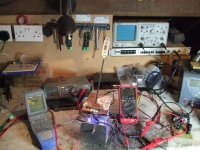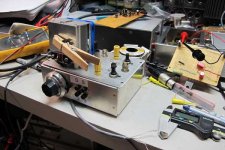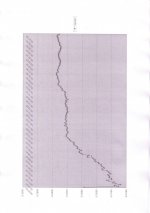pchw, are those dedicated to the 25 F5 builders or will they be for sale??? ThanksI am almost done with matching 130 pairs of these. I measure each device at 1.5A and 0.5A and didn't find them behave very different from the IRF's. As the current goes up, so does the Vgs. I found them very stable once they reach stable operating temp. Can you describe what did you mean by drifting?
Thanks,
I got a couple PM about selling these devices, matched. I would like to help my fellow hobbyist, but I don't have a large sample. Obviously, there are more than what I can use - can't imagine I will build more than 2 (not monster) amps.
Once I finish matching and put aside of my own reserve and 4 quads for another fellow member. I will let go the rest. Manuel, Buzzford, I got your PM, so you 2 will get the first dibs in the ordering of Manuel and Buzzford. **I have no intention to turn this into swap meet, so please email me via the forum if you are interested.**
If Michael wants to put his into the pool for matching, I am more than willing to do the matching for him and hopefully, there will be better yield and benefit more.
At present, my target is within 30mV, but I can tell you that real measurement are actually much better than that if I am only looking at a pair. However, it is a different ball game when I go to triples and quads.
Once I finish matching and put aside of my own reserve and 4 quads for another fellow member. I will let go the rest. Manuel, Buzzford, I got your PM, so you 2 will get the first dibs in the ordering of Manuel and Buzzford. **I have no intention to turn this into swap meet, so please email me via the forum if you are interested.**
If Michael wants to put his into the pool for matching, I am more than willing to do the matching for him and hopefully, there will be better yield and benefit more.
At present, my target is within 30mV, but I can tell you that real measurement are actually much better than that if I am only looking at a pair. However, it is a different ball game when I go to triples and quads.
I was measuring at 2A at 24V in free air for 2 minutes. The VGS does not stop going up.
Yes, the P-Channels seemed a bit more troublesome. the VGS being ~ 5v on them to.
Here are my measurements from the stuff aquired from Mike R.
FQA19N20C
3.7
3.71
3.73
3.73
3.73
3.73
3.74
3.74
3.74
3.74
3.74
3.74
3.74
3.74
3.74
3.75
3.75
3.75
3.75
3.75
3.75
3.76
3.76
3.77
3.78
FQA12P20
5.15
5.18
5.2
5.21
5.22
5.23
5.24
5.25
5.25
5.25
5.26
5.31
5.32
5.32
5.32
5.32
5.33
5.34
5.35
5.35
5.35
5.37
5.38
5.38
5.39
I was intending on ordering 600 or so of each, clearly to resell (this is NOT a commercial thread), and let them be sorted how they come out. Looking for the best methodology. Quads would be the top goal of getting so many.
Yes I want to build the V3 so I can drive my dang OB woofers.
Yes, the P-Channels seemed a bit more troublesome. the VGS being ~ 5v on them to.
Here are my measurements from the stuff aquired from Mike R.
FQA19N20C
3.7
3.71
3.73
3.73
3.73
3.73
3.74
3.74
3.74
3.74
3.74
3.74
3.74
3.74
3.74
3.75
3.75
3.75
3.75
3.75
3.75
3.76
3.76
3.77
3.78
FQA12P20
5.15
5.18
5.2
5.21
5.22
5.23
5.24
5.25
5.25
5.25
5.26
5.31
5.32
5.32
5.32
5.32
5.33
5.34
5.35
5.35
5.35
5.37
5.38
5.38
5.39
I was intending on ordering 600 or so of each, clearly to resell (this is NOT a commercial thread), and let them be sorted how they come out. Looking for the best methodology. Quads would be the top goal of getting so many.
Yes I want to build the V3 so I can drive my dang OB woofers.
Hi
It seems the only real difference between those and these, FQP12P20 and FQP19N20C is that the FQP parts are TO-220 compared to TO-247. It appears they use the same die. If you directly mounted a copper or brass heat slug to the back of the device with a good thermal bond, increasing the surface area to the heatsink insulator, I bet it would closely compare in SOA to the TO-247 version. The max current of the TO-220 parts is only limited by maximum junction temperature. I have done this with other FQP's and surprised myself at how much power they can really handle. It seems many of the FQA's are being phased out but it doesn't mean the transistor is being discontinued. I suspect cost, and since the intended function is of a switch, in most cases TO-220 is sufficient. FQA47P06 is another example of discontinuing TO-247 packages, FQP47P06 is still produced, same die. Also the TO-220 is cheaper.
It seems the only real difference between those and these, FQP12P20 and FQP19N20C is that the FQP parts are TO-220 compared to TO-247. It appears they use the same die. If you directly mounted a copper or brass heat slug to the back of the device with a good thermal bond, increasing the surface area to the heatsink insulator, I bet it would closely compare in SOA to the TO-247 version. The max current of the TO-220 parts is only limited by maximum junction temperature. I have done this with other FQP's and surprised myself at how much power they can really handle. It seems many of the FQA's are being phased out but it doesn't mean the transistor is being discontinued. I suspect cost, and since the intended function is of a switch, in most cases TO-220 is sufficient. FQA47P06 is another example of discontinuing TO-247 packages, FQP47P06 is still produced, same die. Also the TO-220 is cheaper.
Hi Teabag,
It will continues to go up in free air - thermal run away!! Mount the device to a heat sink, and it will stabilize. When I measure the devices, I let each of them run for 2-3 mins on a heat sink (a chunk of metal so to speak ). The Vgs usually settles within a min or so but will continue to change. The reading that I use is after the DMM stop changing or only toggling between 2 mv readings. It usually takes 5-10 mins for me to measure one fet as I don't sit there to watch, and my wife usually looks at me like the angry bird, LOL.
). The Vgs usually settles within a min or so but will continue to change. The reading that I use is after the DMM stop changing or only toggling between 2 mv readings. It usually takes 5-10 mins for me to measure one fet as I don't sit there to watch, and my wife usually looks at me like the angry bird, LOL.
Hi flg,
I wish I could use these for F5X. The transistors for F5X are even harder to match, again the P's are just wild. In fact, all (a few hundred that I had my hands on) Toshiba P-channels (2SJ313, 2SJ618, 2SJ213) had very wide range. The N's are a lot tighter. The list from Mal and Michael pretty much confirm what I am seeing except I have a wider FQA12P20 range, doh!!
It will continues to go up in free air - thermal run away!! Mount the device to a heat sink, and it will stabilize. When I measure the devices, I let each of them run for 2-3 mins on a heat sink (a chunk of metal so to speak
Hi flg,
I wish I could use these for F5X. The transistors for F5X are even harder to match, again the P's are just wild. In fact, all (a few hundred that I had my hands on) Toshiba P-channels (2SJ313, 2SJ618, 2SJ213) had very wide range. The N's are a lot tighter. The list from Mal and Michael pretty much confirm what I am seeing except I have a wider FQA12P20 range, doh!!
I was measuring at 2A at 24V in free air for 2 minutes. The VGS does not stop going up.
I guess I only misunderstand something here??
You don't really heat the mosfet with 48 Watts without a heatsink for 2 minutes, right? In that case I would only wonder why the mosfet does not blow. Of course VGS will never stabilize.
I mean Nelson tested the LU-powerjfet without heatsink, but only for a second or two and not at these power levels.
www.passdiy.com/pdf/matching.pdf
Hannes
I guess I only misunderstand something here??
You don't really heat the mosfet with 48 Watts without a heatsink for 2 minutes, right? In that case I would only wonder why the mosfet does not blow. Of course VGS will never stabilize.
I mean Nelson tested the LU-powerjfet without heatsink, but only for a second or two and not at these power levels.
www.passdiy.com/pdf/matching.pdf
Hannes
I did here, they are warm at that point, not too hot. If I get a good stash I will put them some of my smaller 40W heatsinks that I use for SemiSouth's.
Hi,
Please have a close look at your setup, with 48W heating they should get very hot.
How do you maintain the 2A? Maybe by using a lab supply/current limting? In that case the fets will not see the 24V, but much less (1-2V only).
Hannes
they are warm at that point, not too hot.
Please have a close look at your setup, with 48W heating they should get very hot.
How do you maintain the 2A? Maybe by using a lab supply/current limting? In that case the fets will not see the 24V, but much less (1-2V only).
Hannes
Hannes, I've got a HP lab supply that can do ~10-60v and up to 10A.
I also use a standard FW power supply, checking current and vgs with a couple DMM. with 1-2v, these would not conduct at all. It looks like I am getting pretty normal readings for these Fets.
How are you doing it?
I've got a Rigol scope now to, wondering If I can bring this into play. I want to make the most of it, and that's why I ask. The SemiSouth's hardy drift at all in free-air or heatsink, so the behavior was new to me.
I also use a standard FW power supply, checking current and vgs with a couple DMM. with 1-2v, these would not conduct at all. It looks like I am getting pretty normal readings for these Fets.
How are you doing it?
I've got a Rigol scope now to, wondering If I can bring this into play. I want to make the most of it, and that's why I ask. The SemiSouth's hardy drift at all in free-air or heatsink, so the behavior was new to me.
Hi,
Please have a close look at your setup, with 48W heating they should get very hot.
How do you maintain the 2A? Maybe by using a lab supply/current limting? In that case the fets will not see the 24V, but much less (1-2V only).
Hannes
Funny how 24 V 2 A I am doing the same but got no problem with mosfet getting hot as I am using a constant temperature rig and take VGS at 50C
no mather which day / time it is and how many time I mesure them I always get same results
Attachments
Hi Bksabath, please look closely, he is not using a heatsink at all!
TeaBag, you're mixing up VGS and VDS. I said VDS might be 1-2 V, not VGS. If you're using a lab supply with current limiting and limit current to 2A, it will not output 20V, but only the highest voltage that still permits the 2A. Otherwise how should the current limit work at all?
I'm using a heatsink with temperature controlled forced cooling Hannes
Hannes
with 1-2v, these would not conduct at all.
TeaBag, you're mixing up VGS and VDS. I said VDS might be 1-2 V, not VGS. If you're using a lab supply with current limiting and limit current to 2A, it will not output 20V, but only the highest voltage that still permits the 2A. Otherwise how should the current limit work at all?
How are you doing it?
I'm using a heatsink with temperature controlled forced cooling
My wife was talking about "micro-pipetting" this morning and how it is important to establish a rhythm as you fill up the cell lines and make your standardized runs. It's the same with matching MOSFETs -- you put them in the test jig for only a certain period of time and move onto the next. I would sometimes take out a batch I had matched weeks earlier and using the same technique get Vgs and gm to line up perfectly. I would say that one thing to try and keep constant is the ambient temperature when you start out matching. My lab runs around 21 degrees most of the year.
I made this other jig, but found that the results weren't any better than the original method.
It does help if you current limit the test jig, fwiw.
I made this other jig, but found that the results weren't any better than the original method.
It does help if you current limit the test jig, fwiw.
Attachments
My lab runs around 21 degrees most of the year.
QUOTE]
My Labwas at 14 C yesterday 24C at present 5C last week
weather is realy bonker here in Chester UK only last week first snow I have seen for it lasted about 10 minutes
Today is warmer than it was most days last July
I got same FQA12P20 to match before I start I got graph of VGS from 24 to 51 C at which rig setle.
Is not perfect but if I take reading with same conditions results are prety good
Attachments
I have took a look on datasheet (FQA36P15) and as I can understand it, these are promising for me.
Ciss seems a littlebit high, but what, for a 294W dissipation capable device?
gFS 19,5 I think it is great!
But there are much more competent persons, than me.
Gyuri
Ciss seems a littlebit high, but what, for a 294W dissipation capable device?
gFS 19,5 I think it is great!
But there are much more competent persons, than me.
Gyuri
Last edited:
- Status
- This old topic is closed. If you want to reopen this topic, contact a moderator using the "Report Post" button.
- Home
- Amplifiers
- Pass Labs
- Fqa12p20 Fqa19n20c Discontinuation


